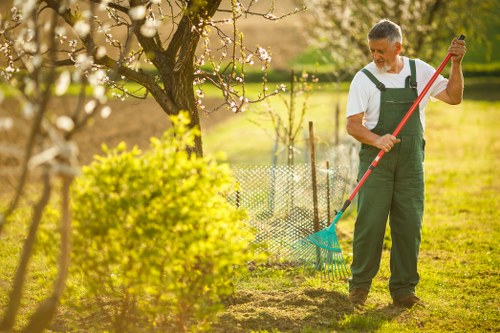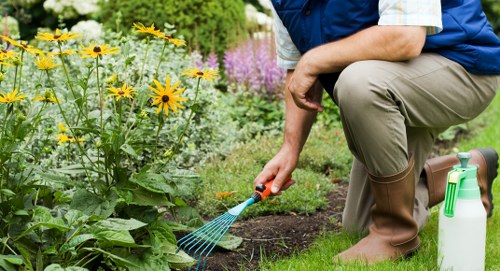Comprehensive Guide to Garden Maintenance in Camberwell

Introduction to Garden Maintenance
Maintaining a beautiful garden in Camberwell requires dedication, knowledge, and the right resources. Whether you're a seasoned gardener or a beginner, understanding the essentials of garden maintenance can transform your outdoor space into a vibrant and thriving oasis.
Camberwell's unique climate and soil conditions mean that specific care practices must be adopted to ensure your garden flourishes throughout the year. From selecting the right plants to implementing effective watering strategies, every aspect plays a crucial role in the health of your garden.
In this guide, we'll explore the key elements of garden maintenance in Camberwell, providing you with actionable tips and insights to keep your garden in pristine condition.

Seasonal Garden Care
Spring Maintenance
Spring is a pivotal season for garden maintenance in Camberwell. As the weather warms up, it's essential to prepare your garden for the growing season.
Key Tasks:
- Pruning: Trim back any dead or overgrown branches to promote healthy growth.
- Weeding: Remove unwanted weeds that compete with your plants for nutrients and water.
- Soil Preparation: Enrich the soil with compost or organic matter to enhance fertility.
Additionally, consider planting spring-blooming flowers such as tulips and daffodils to add vibrant colors to your garden.
Summer Maintenance
Summer in Camberwell brings longer days and abundant sunlight, making it the perfect time to focus on the growth and health of your plants.
Essential Practices:
- Regular Watering: Ensure your plants receive adequate water, especially during heatwaves.
- Pest Control: Monitor for common garden pests and take appropriate measures to control them.
- Mulching: Apply mulch to retain soil moisture and suppress weed growth.
Summer is also an excellent time to harvest vegetables and herbs, encouraging further growth and productivity.

Essential Tools for Garden Maintenance
Basic Gardening Tools
Having the right tools is fundamental to effective garden maintenance. Invest in high-quality equipment that can withstand Camberwell's climate.
- Pruners: For trimming and shaping plants.
- Spade: Essential for digging and soil preparation.
- Garden Hose: Ensure it has adjustable nozzles for versatile watering needs.
Advanced Equipment
For more extensive garden projects, consider investing in advanced tools such as:
- Lawn Mower: To maintain a well-manicured lawn.
- Leaf Blower: Efficiently clears leaves and debris.
- Compost Bin: Facilitates the recycling of organic waste into nutrient-rich compost.
Using the right tools not only makes garden maintenance easier but also enhances the overall health and appearance of your garden.

Plant Selection and Care
Choosing the Right Plants
Selecting plants that thrive in Camberwell's environment is crucial for a successful garden. Consider factors such as sunlight, soil type, and water requirements when choosing plants.
- Native Plants: These are well-adapted to the local climate and require less maintenance.
- Perennials: Offer long-term beauty as they return each year.
- Seasonal Flowers: Add color and variety throughout the year.
Ongoing Plant Care
Once you've selected the right plants, proper care ensures they remain healthy and vibrant. Regularly monitor for signs of stress, disease, or pests, and address issues promptly.
Watering: Adjust watering schedules based on seasonal needs and rainfall.
Fertilizing: Provide necessary nutrients through organic or synthetic fertilizers.

Lawn Care in Camberwell
Maintaining a Healthy Lawn
A well-maintained lawn can significantly enhance the aesthetic appeal of your garden. Here are key practices for lawn care in Camberwell:
- Mowing: Regular mowing at the appropriate height encourages dense growth.
- Aeration: Improve soil aeration to promote healthy root development.
- Overseeding: Fill in bare spots and maintain lawn thickness.
Dealing with Common Lawn Problems
Address common lawn issues such as brown patches, weed infestation, and pests by implementing targeted solutions:
- Brown Patches: Often caused by drought or fungal diseases; ensure proper watering and apply fungicides if necessary.
- Weeds: Use appropriate herbicides or manual removal to keep the lawn weed-free.
- Pests: Identify and treat common lawn pests to prevent damage.
Regular maintenance and proactive care will keep your lawn lush and healthy throughout the year.
Garden Design and Layout
Creating a Functional Layout
Effective garden design optimizes space usage and enhances the overall appearance. Consider the following elements when planning your garden layout:
- Pathways: Facilitate easy movement and add a decorative touch.
- Plant Beds: Organize plants based on their size, color, and growing requirements.
- Seating Areas: Create spaces for relaxation and enjoyment.
Incorporating Decorative Features
Add visual interest to your garden with decorative elements such as:
- Garden Lighting: Enhance beauty and safety during evenings.
- Fountains and Water Features: Introduce soothing sounds and attract wildlife.
- Garden Art: Personalize your space with sculptures, statues, and other artistic pieces.
A well-designed garden not only looks stunning but also provides a harmonious environment for both plants and people.
Sustainable Gardening Practices
Eco-Friendly Techniques
Embracing sustainable gardening practices helps protect the environment while maintaining a beautiful garden. Implement the following eco-friendly techniques:
- Composting: Recycle organic waste into nutrient-rich compost for your plants.
- Rainwater Harvesting: Collect and store rainwater for irrigation purposes.
- Native Planting: Use native species that require less water and are more resistant to local pests.
Reducing Chemical Usage
Minimize the use of chemical fertilizers and pesticides by opting for natural alternatives. Consider:
- Organic Fertilizers: Enhance soil fertility without harmful side effects.
- Biological Pest Control: Introduce beneficial insects that naturally control pest populations.
- Integrated Pest Management: Combine various pest control methods to reduce reliance on chemicals.
Sustainable gardening not only benefits the environment but also promotes healthier plant growth.
Professional Garden Maintenance Services
Benefits of Hiring Professionals
While DIY garden maintenance is rewarding, hiring professional services in Camberwell offers numerous advantages:
- Expertise: Professionals possess the knowledge and experience to address complex garden issues.
- Time-Saving: Delegate time-consuming tasks to focus on other aspects of your life.
- Customized Solutions: Receive tailored maintenance plans that suit your garden's specific needs.
Choosing the Right Service Provider
Select a reputable garden maintenance service by considering the following factors:
- Experience: Look for providers with a proven track record in garden maintenance.
- Services Offered: Ensure they offer the specific services you require.
- Customer Reviews: Check testimonials and reviews to gauge customer satisfaction.
Investing in professional garden maintenance can elevate the health and appearance of your garden, ensuring it remains a source of pride and joy.
Seasonal Planting and Plant Care
Autumn Maintenance
Autumn is a critical season for preparing your garden for the colder months. Focus on tasks that will protect your plants and soil.
- Leaf Removal: Clear fallen leaves to prevent fungal diseases.
- Planting Bulbs: Plant spring-blooming bulbs like daffodils and tulips.
- Soil Testing: Assess and adjust soil pH levels as needed.
Winter Care
Winter poses challenges for garden maintenance, but with proper care, your garden can remain healthy:
- Protecting Plants: Use mulch or covers to shield sensitive plants from frost.
- Planning: Use the downtime to plan next year's garden layout and plant selections.
- Tool Maintenance: Clean and store gardening tools to prolong their lifespan.
By addressing these tasks, you ensure a smooth transition into the next growing season.
Spring Revival
As winter fades, it's time to breathe new life into your garden:
- Clearing Debris: Remove any remaining winter residue from garden beds.
- Early Planting: Start sowing seeds for early-blooming plants.
- Soil Enrichment: Add fresh compost to invigorate the soil.
Preparing in spring sets the foundation for a productive and vibrant garden throughout the year.
Water Management in Camberwell Gardens
Efficient Watering Practices
Water management is integral to garden maintenance, especially in areas like Camberwell where weather patterns can vary.
- Drip Irrigation: Provides targeted watering, reducing water waste.
- Rain Barrels: Collect rainwater for sustainable irrigation.
- Watering Schedule: Water plants during the early morning or late evening to minimize evaporation.
Drought-Resistant Plants
Incorporating drought-resistant plants can help maintain a healthy garden with less water:
- Succulents: Thrive in dry conditions with minimal watering.
- Lavender: Requires well-drained soil and infrequent watering.
- Hostas: Prefer less water once established.
Choosing plants that are adapted to Camberwell's climate ensures longevity and reduces the need for constant watering.
Pest and Disease Management
Identifying Common Pests
Keeping your garden free from pests is essential for plant health. Common pests in Camberwell include:
- Aphids: Tiny insects that suck plant sap, causing deformities.
- Slugs and Snails: Devour leaves and stems, particularly at night.
- Snakes: While beneficial for controlling pests, their presence might be unwelcome to some gardeners.
Natural Pest Control Methods
Opt for environmentally friendly pest control methods to protect your garden:
- Beneficial Insects: Introduce ladybugs and predatory beetles to control aphid populations.
- Neem Oil: A natural pesticide that deters a variety of pests.
- Handpicking: Manually remove larger pests like slugs and snails.
Preventing Plant Diseases
Prevent plant diseases by maintaining proper hygiene and plant care:
- Good Air Circulation: Ensure plants are spaced adequately to prevent mildew and rot.
- Watering Techniques: Avoid overhead watering to reduce the risk of fungal infections.
- Resistant Varieties: Choose plant varieties that are resistant to common diseases.
Soil Health and Fertilization
Understanding Soil Composition
Healthy soil is the foundation of a thriving garden. Understanding Camberwell's soil composition helps in making informed maintenance decisions.
- Soil pH: Test and adjust soil pH to suit the plants you are cultivating.
- Organic Matter: Incorporate compost or well-rotted manure to improve soil structure.
- Drainage: Ensure proper drainage to prevent waterlogging and root diseases.
Effective Fertilization
Fertilizing your garden provides essential nutrients that promote healthy growth:
- Nitrogen: Encourages leaf and stem development.
- Phosphorus: Supports root growth and flower production.
- Potassium: Enhances overall plant health and disease resistance.
Use a balanced fertilizer and follow application guidelines to avoid over-fertilization, which can harm plants and the environment.
Composting for Nutrient-Rich Soil
Composting recycles organic waste into valuable soil amendments:
- Kitchen Scraps: Vegetable peels, coffee grounds, and eggshells are excellent compost materials.
- Yard Waste: Grass clippings, leaves, and plant trimmings enrich the compost.
- Maintenance: Regularly turn the compost pile to aerate and speed up decomposition.
Incorporate compost into your garden beds to enhance soil fertility and structure.
Mulching Techniques
Benefits of Mulching
Mulching offers numerous benefits that contribute to overall garden health:
- Moisture Retention: Keeps the soil moist by reducing evaporation.
- Weed Suppression: Prevents weed growth by blocking sunlight.
- Temperature Regulation: Maintains consistent soil temperatures, protecting roots from extreme heat or cold.
Types of Mulch
Choose the appropriate type of mulch based on your garden's needs:
- Organic Mulch: Includes bark, straw, and compost; improves soil quality as it decomposes.
- Inorganic Mulch: Consists of gravel, pebbles, or rubber; effective for weed control but doesn't enhance soil fertility.
- Living Mulch: Groundcovers that provide natural coverage while adding aesthetic value.
Application Tips
To maximize the benefits of mulching:
- Depth: Apply mulch in a layer 2-3 inches thick.
- Placement: Keep mulch a few inches away from plant stems to prevent rot.
- Maintenance: Replenish mulch as needed to maintain its effectiveness.
Pruning and Trimming
When to Prune
Proper pruning is essential for the health and appearance of your plants. Knowing the right time to prune ensures optimal growth:
- Spring-Blooming Plants: Prune immediately after flowering.
- Summer-Blooming Plants: Prune in late winter or early spring.
- Fruit Trees: Conduct pruning during dormancy to promote fruit production.
Pruning Techniques
Implement effective pruning techniques to maintain plant health:
- Remove Deadwood: Cut away any dead or diseased branches.
- Shape Plants: Trim to maintain desired shapes and sizes.
- Thin Out: Reduce overcrowding to improve air circulation and light penetration.
Tools and Safety
Use the right tools and follow safety precautions when pruning:
- Sharp Pruners: Ensure clean cuts to prevent damage to plants.
- Ladder Safety: Use stable ladders and have a spotter if necessary.
- Protective Gear: Wear gloves and eye protection to prevent injuries.
Creating a Sustainable Garden
Eco-Friendly Practices
Adopting sustainable practices makes your garden environmentally friendly and resource-efficient:
- Rain Gardens: Designate areas to capture and utilize rainwater effectively.
- Permeable Paving: Use materials that allow water to seep into the ground, reducing runoff.
- Native Plant Selection: Choose plants that require less water and are adapted to local conditions.
Energy Conservation
Implementing energy-saving measures contributes to a sustainable garden:
- Solar Lighting: Use solar-powered garden lights to reduce electricity usage.
- Manual Tools: Opt for hand tools over powered equipment to save energy and reduce emissions.
- Composting: Minimize waste and create natural fertilizer through composting.
Wildlife-Friendly Gardens
Encourage biodiversity by creating habitats for local wildlife:
- Birdhouses: Attract birds that help control pests.
- Bee-Friendly Plants: Plant flowers that provide nectar and pollen for bees.
- Pond Areas: Support amphibians and beneficial insects.
Fostering a wildlife-friendly garden enhances its ecological balance and resilience.
Irrigation Systems
Choosing the Right System
Selecting an appropriate irrigation system ensures efficient water usage and healthy plant growth:
- Drip Irrigation: Delivers water directly to plant roots, minimizing evaporation.
- Splash Systems: Suitable for larger areas but less water-efficient.
- Automatic Timers: Regulate watering schedules for consistent moisture levels.
Installation and Maintenance
Proper installation and regular maintenance of irrigation systems are crucial:
- Professional Installation: Ensures the system is set up correctly and efficiently.
- Regular Inspections: Check for leaks, clogs, and other issues that can affect performance.
- System Upgrades: Incorporate smart technology for better water management.
Water Conservation Tips
Maximize water efficiency with these conservation strategies:
- Mulching: Reduces water evaporation from the soil.
- Rainwater Harvesting: Utilize collected rainwater for irrigation.
- Drought-Tolerant Plants: Incorporate plants that require less water.
Efficient irrigation practices contribute to a sustainable and cost-effective garden.
Hardscaping Elements
Incorporating Structures
Hardscaping adds structure and functionality to your garden:
- Paths and Walkways: Guide movement and add visual interest.
- Patios and Decks: Provide spaces for outdoor seating and activities.
- Fencing and Walls: Define boundaries and offer privacy.
Choosing Materials
Select materials that complement your garden's aesthetic and are durable in Camberwell's climate:
- Natural Stone: Timeless and versatile for various garden styles.
- Brick: Offers a classic look with excellent durability.
- Recycled Materials: Eco-friendly options that add unique character.
Maintenance of Hardscaping
Maintain hardscaping elements to ensure their longevity and appearance:
- Regular Cleaning: Remove debris and stains to keep surfaces looking fresh.
- Repairs: Address any cracks or damages promptly to prevent further issues.
- Sealing: Apply sealants to protect surfaces from weathering.
Garden Lighting
Importance of Lighting
Garden lighting enhances the beauty and functionality of your garden, especially during evenings:
- Safety: Illuminates pathways and reduces the risk of accidents.
- Aesthetics: Highlights garden features and creates ambiance.
- Security: Deters unwanted visitors by making your garden more visible.
Types of Garden Lighting
Choose from various lighting options to suit your garden's needs:
- Solar Lights: Eco-friendly and easy to install without wiring.
- LED Fixtures: Energy-efficient and long-lasting lighting solutions.
- String Lights: Add a festive touch to seating areas and outdoor gatherings.
Installation Tips
For effective garden lighting:
- Strategic Placement: Position lights to accentuate key garden elements.
- Layered Lighting: Combine different types of lights for a dynamic effect.
- Maintenance: Regularly check and replace bulbs to ensure consistent illumination.
Creating a Low-Maintenance Garden
Plant Selection
Opt for plants that require minimal care while still providing beauty:
- Evergreens: Maintain their foliage year-round with little upkeep.
- Perennials: Come back each season without the need for replanting.
- Groundcovers: Suppress weeds and reduce the need for frequent mowing.
Smart Garden Design
Design your garden to minimize maintenance efforts:
- Zoning: Group plants with similar care requirements together.
- Irrigation: Implement efficient watering systems to reduce manual tasks.
- Pathways: Use durable materials that require less cleaning and upkeep.
Using Mulch and Groundcovers
Mulch and groundcovers are excellent for reducing maintenance:
- Mulch: Retains soil moisture and reduces weed growth.
- Groundcovers: Provide natural coverage, eliminating the need for frequent mowing.
- Permanant Ground Cover Plants: Require minimal pruning and care.
By creating a low-maintenance garden, you can enjoy a beautiful outdoor space with less effort and time.
Conclusion
Maintaining a garden in Camberwell is a rewarding endeavor that enhances your home's beauty and provides a tranquil retreat. By understanding the unique requirements of the local climate, selecting appropriate plants, and implementing effective maintenance practices, you can cultivate a thriving garden throughout the year.
Whether you choose to tackle garden maintenance yourself or enlist the help of professionals, the key to success lies in consistent care and a well-thought-out plan.
Ready to transform your garden? Contact us today to book your garden maintenance service and enjoy a lush, vibrant garden in Camberwell.